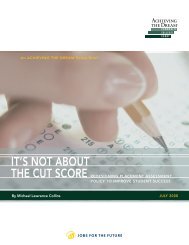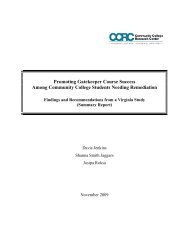Understanding University Success - Educational Policy ...
Understanding University Success - Educational Policy ...
Understanding University Success - Educational Policy ...
Create successful ePaper yourself
Turn your PDF publications into a flip-book with our unique Google optimized e-Paper software.
English 25<br />
A report from Standards for <strong>Success</strong><br />
C. <strong>Success</strong>ful students know conventions<br />
of spelling. They:<br />
C.1.<br />
C.2.<br />
C.3.<br />
use a dictionary and other<br />
resources to spell new,<br />
unfamiliar or difficult words.<br />
differentiate between commonly<br />
confused terms, such as “its” and<br />
“it’s” or “affect” and “effect.”<br />
know how to use the spellchecker<br />
and grammar check<br />
function in word processing<br />
software while understanding the<br />
limitations of relying upon these<br />
tools.<br />
D. <strong>Success</strong>ful students use writing<br />
conventions to write clearly and<br />
coherently. They:<br />
D.1. know and use several prewriting<br />
strategies, including<br />
developing a focus; determining<br />
the purpose; planning a<br />
sequence of ideas; using<br />
structured overviews; and<br />
creating outlines.<br />
D.2. use paragraph structure in<br />
writing as manifested by the<br />
ability to construct coherent<br />
paragraphs and arrange<br />
paragraphs in logical order.<br />
D.3. use a variety of sentence<br />
structures appropriately in<br />
writing, including compound,<br />
complex, compound-complex,<br />
parallel, repetitive and<br />
analogous sentence structures.<br />
D.4. present ideas to achieve overall<br />
coherence and logical flow in<br />
writing and use appropriate<br />
techniques such as transitions<br />
and repetition to maximize<br />
cohesion.<br />
D.5. use words correctly; use words<br />
that mean what the writer<br />
intends to say; and use a varied<br />
vocabulary.<br />
D.6.* demonstrate development of<br />
a controlled yet unique style<br />
and voice in writing where<br />
appropriate.<br />
D.7.*<br />
use a style manual, such as the<br />
Modern Language Association<br />
(MLA) or the American<br />
Psychological Association (APA)<br />
to apply writing conventions<br />
and to create documentation<br />
formats in a manner consistent<br />
with the manual.<br />
E. <strong>Success</strong>ful students use writing to<br />
communicate ideas, concepts, emotions<br />
and descriptions to the reader. They:<br />
E.1.<br />
E.2.<br />
E.3.<br />
E.4.<br />
E.5.<br />
E.6.<br />
know the difference between a<br />
topic and a thesis.<br />
articulate a position through a<br />
thesis statement and advance<br />
it using evidence, examples<br />
and counterarguments that are<br />
relevant to the audience or<br />
issue at hand.<br />
use a variety of methods to<br />
develop arguments, including<br />
compare-contrast reasoning;<br />
logical arguments (inductivedeductive);<br />
and alternation<br />
between general and specific<br />
(e.g., connections between<br />
public knowledge and personal<br />
observation and experience).<br />
write to persuade the reader by<br />
anticipating and addressing<br />
counterarguments, by using<br />
rhetorical devices and by<br />
developing an accurate and<br />
expressive style of<br />
communication that moves<br />
beyond mechanics to add flair<br />
and elegance to writing.<br />
use a variety of strategies to<br />
adapt writing for different<br />
audiences and purposes, such<br />
as including appropriate<br />
content and using appropriate<br />
language, style, tone and<br />
structure.<br />
distinguish between formal and<br />
informal styles, for example,<br />
between academic essays and<br />
personal memos.






